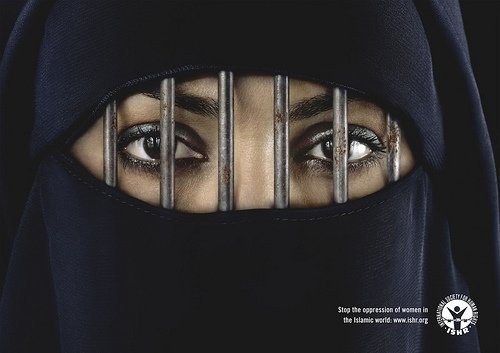
During their New Moon promo tour a couple of months back, the Twilight Trio was on Jimmy Kimmel Live, and at the end of the show Kimmel let a few people from the audience ask questions of the cast. A girl came up to the mic with a question for Taylor Lautner. “I really like your shirt,” she said. “I was wondering, can I have it?” The running joke about New Moon, of course, is the extent of the shirtlessness perpetrated by Lautner’s character and his werewolf brethren. (It’s gone so far, in fact, that Lautner, who beefed up special for the role, has vowed to never appear shirtless in a movie ever again.) As Lautner struggled in response to keep from losing his shirt and his dignity, Kimmel, possibly the oldest person in the entire studio at that moment, interjected, “You know, I think people would look down on men for demanding the shirt off a woman.” Yet that this interaction seemed totally acceptable and par for the course to the otherwise teenage audience struck me as an indication of a potentially far lager trend a few days later, when I saw “The Christian Side Hug” video.
If you’re wondering what on earth is that?? The “Christian Side Hug” is a rap performed by a group of white kids at a Christian youth gathering, about a way of hugging while standing side by side with someone as opposed to facing one another and putting your arm around their shoulders or waist, because, “front hugs be too sinful.” Despite ultimately turning out to have been intended as insider “satire” (though not before passing very convincingly as both 1. A typically “ass-backwards” — to employ a Palin-ism — move from the abstinence movement of promoting celibacy while sexualizing even mundane forms of human contact, as well as, 2. A reason to weep quietly for the final, ignominious death — like a sad toothless crack-addict in an abandoned alley — of hip hop), I happened to see the Christian Side Hug video on the same day as the fallout from Adam Lambert’s American Music Awards performance, and to me there was a certain similarity between the two.
In case you happened to have missed it, or hearing about it, Lambert put on a rather racy, sexually scandalizing live performance at the awards show.

Perhaps confusing the AMA’s with the MTV Movie Awards, which have no problem rewarding male makeouts, or, more likely, shrewdly pushing the envelope hard on the night before his debut album release, in his first televised performance since the finale of American Idol, Lambert “shocked” the audience at Los Angeles’ Nokia Theatre and the millions watching live on ABC by closing the show with a risqué rendition of “For Your Entertainment,” the first single of his album of the same name. Highlights from the controversial performance included simulated oral sex from a male backup dancer, a make-out session with his male keyboardist, and a giant mirrored prop set up on the stage so the audience could see the looks on their own shocked faces.
According to Rolling Stone, the producers of the show weren’t informed about the guy-on-guy kiss in advance, and after the show, Lambert told the magazine the musician he kissed is a straight man. In the aftermath, ABC canceled Lambert’s Good Morning America appearance slated for the next day, which of course only helped generate even more attention and fanfare for the artist, who has clearly become an expert at navigating the myriad controversies he’s racked up. To me, what connects Lambert’s performance and the Christian Side Hug and the Kimmel incident, as well as endless other examples from our current pop culture, extends beyond any particular sexual orientation and includes even abstinence itself. It’s an underlying aggressiveness to sexuality in general: agro-sexuality.
To be clear, I’m not talking about aggression enacted through sex, but rather about a militancy in the display of one’s approach to sexuality. The past decade’s proliferation of online profiles, digital cameras, and all manner of social technologies has demanded we approach basically every other aspect of our modern identities as a performative display. It only makes sense that sexuality wouldn’t be exempt.
When I was a teenager in the late 90’s the general approach to sexuality could easily have been described as “come as you are.” Kurt Cobain had died the year before I started high school, Britney Spears’ first album wouldn’t come out until I was halfway through, and in between there was a lot of Green Day, Jewel, Fugees, and REM. Rap was still busy beefing between the coasts to have gotten fully pornified yet. Heroin Chic, an aesthetic glamorizing a drug that destroys sex drive, was all the rage. Even Madonna was, by this time, more interested in acting and electronica than vogueing or kink. And AIDS was huge. People were still dying of AIDS then. As opposed to now, when people are living with it. Kids were obviously still having sex, but since there was some semblance of sex education going on under the Clinton administration they were getting pregnant a lot less than in the “abstinence-only” Bush era. Basically, aside from the effort pushing the word “safe” in front of it, sex in the 90’s was not something to get particularly militant about.
Of course, there was the gay rights movement, but by the time Ellen Degeneres was making the cover of Time for admitting, yep, she’s gay, it had already long been transmogrified from Activism to Pride. And perhaps it’s this shift from social justice to self-expression that is the root of Agrosexuality in general. After all, what are purity rings if not emblems of Abstinence Pride? And in some basic way, even the demand for the shirt off Lautner’s back was as much a performance of sexuality as was Lambert’s on the AMA’s.
In a 2006 New York Magazine article called “The Cuddle Puddle of Stuyvesant High School” Alex Morris wrote:
Go to the schools, talk to the kids, and you’ll see that somewhere along the line this generation has started to conceive of sexuality differently. Ten years ago in the halls of Stuyvesant you might have found a few goth girls kissing goth girls, kids on the fringes defiantly bucking the system. Now you find a group of vaguely progressive but generally mainstream kids for whom same-sex intimacy is standard operating procedure. These teenagers don’t feel as though their sexuality has to define them, or that they have to define it, which has led some psychologists and child-development specialists to label them the “post-gay” generation. But kids like Alair and her friends are in the process of working up their own language to describe their behavior. Along with gay, straight, and bisexual, they’ll drop in new words, some of which they’ve coined themselves: polysexual, ambisexual, pansexual, pansensual, polyfide, bi-curious, bi-queer, fluid, metroflexible, heteroflexible, heterosexual with lesbian tendencies—or, as Alair puts it, “just sexual.”
Even the nouveau-celibacy of the abstinence movement is an option on this spectrum, its appeal (if not necessarily its effectiveness) one kind of response to all these overwhelming new choices. As alternative sexuality has become more mainstream, and sexuality moves from self definition to self expression, what has emerged is a new agrosexual attitude that really wasn’t there 10 years ago. There’s an expectancy of an in-your-face show of sexuality — whatever yours may be — as part OF sexuality itself. It’s by no means anything new, but it used to be employed by those who’d followed alternative sexual paths, flying their freak flags as a social statement, or for deliberate shock value, now, however, as the sexual mainstream is fragmenting along with the cultural one being agrosexual is par for everyone’s course.
In her LA Times article on Lady Gaga — likely as close to the embodiment of agrosexuality as a generation could hope for — Ann Powers writes:
Having gotten her start in the bohemian enclaves of downtown New York City, Gaga is deeply indebted to Warhol’s “Superstar”-oriented Factory scene and its aftermath, which produced drag performers like Candy Darling, artists such as Robert Mapplethorpe and streetwise rock stars including Lou Reed and Patti Smith.
“The idea is, you are your image, you are who you see yourself to be,” she said. “It’s iconography.”
Warhol supported and exploited a coterie of outsiders who likely would never have emerged from their corners without his help. Gaga takes control but also shows herself losing it; she blurs the lines between self-realization and self-objectification, courting the dangers of full exposure for a generation of kids born with camcorders in their hands.
Though she talks nonstop about liberation, Gaga’s work abounds with images of violation and entrapment. In the 1980s, Madonna employed bondage imagery, and it felt sexual. Gaga does it, and it looks like it hurts.
She says she wants her fans to feel safe in expressing their imperfections. “I want women — and men — to feel empowered by a deeper and more psychotic part of themselves. The part they’re always trying desperately to hide. I want that to become something that they cherish.”
Trendwatching.com calls this “Maturialism,” one of its “10 Crucial Consumer Trends for 2010:”
Let’s face it: this year will be rawer, more opinionated, more risqué, more in your face than ever before. Your audiences (who are by now thoroughly exposed to, well, anything, for which you can thank first and foremost the anything-goes online universe) can handle much more quirkiness, more daring innovations, more risqué communications and conversations, more exotic flavors and so on than traditional marketers could have ever dreamed of….We’ve dubbed this MATURIALISM (mature materialism),
In fact, the image at the top of this post is an ad for UK ice cream brand The Ice Creamists, mentioned in the Trendwatching post as an example of Maturialism in action:
Trendwatching suggests that if they want to keep up with culture, brands need to mirror the current societal norms that are “about anything but being meek.” In other words, this isn’t just for teenagers and pop stars; brands need to get in on the agrosexual action, too.


 Office chairs in people’s minds had a certain aesthetic. They were cushioned and upholstered. The Aeron chair of course isn’t. There was nothing familiar about it. Maybe the word ‘ugly’ was just a proxy for “different.” The people reporting their first impressions misinterpreted their own feelings. They said they hated it. But what they really meant was that the chair was so new and unusual that they weren’t used to it…. Buried among the things that we hate is a class of products that are in that category only because they are weird. They make us nervous. They are sufficiently different that it takes us time to understand that we actually like them.
Office chairs in people’s minds had a certain aesthetic. They were cushioned and upholstered. The Aeron chair of course isn’t. There was nothing familiar about it. Maybe the word ‘ugly’ was just a proxy for “different.” The people reporting their first impressions misinterpreted their own feelings. They said they hated it. But what they really meant was that the chair was so new and unusual that they weren’t used to it…. Buried among the things that we hate is a class of products that are in that category only because they are weird. They make us nervous. They are sufficiently different that it takes us time to understand that we actually like them.



